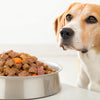Can I Freeze Wet Dog Food? Your Comprehensive Guide to Safe Storage Practices
- Houndsy
Table of Contents
- Introduction
- The Basics of Canned Dog Food
- Can You Freeze Canned Dog Food?
- Best Practices for Freezing Canned Dog Food
- Feeding Rituals and Pet Well-Being
- Conclusion
- FAQs
Introduction
Have you ever found yourself in a tug-of-war with your dog's appetite? One minute they’re eagerly devouring their meal, and the next, you’re left with half a can of uneaten wet food. It's a familiar scenario for many pet owners, and it raises an important question: can I freeze wet dog food? The answer is more nuanced than you might think, highlighting the need for effective storage solutions that cater to both convenience and your furry friend’s health.
Statistics suggest that about 50% of dog owners are unsure how to properly store leftover wet food, leading to wasted product and potential health risks for their pets. Understanding the dos and don'ts of freezing wet dog food can significantly elevate your pet care routine, ensuring food quality while maximizing savings.
In this blog post, we aim to demystify the topic of freezing wet dog food by discussing its safety, best practices for storage, and how it impacts your dog's health and mealtime experience. By the end of this article, you'll be equipped with practical knowledge that allows you to make informed decisions about storing your pet's food more optimally.
We encourage you to reflect on your current feeding practices: how do you manage your dog’s leftover food, and are there ways to improve or simplify this aspect of your pet care? Our ultimate goal is to empower you with the insights needed to ensure your pampered pooch always enjoys fresh, nutritious meals—whether from the can or the freezer.
The Basics of Canned Dog Food
What is Canned Dog Food?
Canned dog food, often labeled as wet dog food, is a popular choice among pet owners for several reasons. With its palatable taste and higher moisture content, it tends to be highly appealing to dogs. Unlike dry kibble, most wet foods contain higher percentages of protein and fat, making it an excellent choice, particularly for picky eaters or dogs with specific dietary needs. However, once a can is opened, questions around storage and longevity arise.
Nutritional Considerations
Before diving into freezing practices, it’s essential to understand the nutritional aspects of wet dog food. Many brands craft formulas that cater to varying dietary needs—from age-specific diets to those addressing health issues. This not only helps you choose an appropriate food for your dog but also reinforces the importance of maintaining food quality during storage. A reputable manufacturer will ensure that the ingredients meet high nutritional standards, contributing directly to your dog's overall well-being.
Shelf Life and Storage Guidelines
Unopened canned dog food typically boasts a long shelf life, often lasting up to two years when stored in proper conditions. However, the clock starts ticking as soon as you pop the lid open. Opened cans should ideally be refrigerated and consumed within three to five days to avoid spoilage. In this light, understanding efficient storage practices is critical for managing leftover food and ensuring your dog's meals remain fresh. This leads us to the question: can you freeze canned dog food?
Can You Freeze Canned Dog Food?
The Short Answer: Yes, You Can!
Yes, you certainly can freeze canned dog food, but it’s important to consider several factors before doing so. Freezing can extend the lifespan of the food, making it a smart choice for pet owners who use partial cans. However, it’s vital to understand that freezing can have effects on the food's texture and consistency.
Effects of Freezing on Canned Dog Food
-
Texture and Consistency: Freezing can alter the texture of wet dog food. Once thawed, the food may become grainy or lose its original form, particularly if it contains high moisture levels or specific stabilizers.
-
Flavor Profile: Many dogs prefer the taste of freshly opened food. While some may notice a difference in flavor after freezing, most adapt quickly, particularly if you warm the food slightly before serving.
-
Nutritional Value: Freezing doesn’t significantly diminish the nutritional content of wet dog food, but it's crucial to check for quality upon thawing. Over time, exposure to air can also affect the nutritional integrity, hence the need for airtight storage containers.
Best Practices for Freezing Canned Dog Food
Step-by-Step Guide
If you decide to freeze your dog’s leftover food, here’s how to do it correctly:
-
Portion Control: Divide the food into individual servings. Using smaller portions simplifies thawing, as you won’t need to refreeze any leftovers.
-
Use Airtight Containers: Transfer the portions into airtight containers or freezer-safe bags. Removing excess air can help minimize freezer burn, ensuring the food maintains its quality.
-
Label and Date: Always label each container with the date and contents. This step helps keep track of how long the food has been in the freezer and ensures you use the older portions first.
-
Freeze Promptly: Aim to freeze leftovers as soon as possible after opening. This practice minimizes the potential for spoilage before they are frozen.
-
Thawing Safely: When you’re ready to use the frozen food, thaw it in the refrigerator overnight. If you're short on time, you may also use a microwave on a low setting. Avoid defrosting it at room temperature to prevent bacterial growth.
Alternative Storage Methods
While freezing is an effective option, there are other storage methods to consider:
-
Refrigeration: Opened canned dog food can be safely stored in the refrigerator for up to three to five days. Utilize a silicone lid designed for pet food cans to retain moisture and minimize odors.
-
Homemade Treats: If you find that your dog consistently leaves food behind, consider using leftovers to create homemade dog treats. Mixing it with oats and baking it into small bites can lessen waste and give your pup a tasty snack.
Feeding Rituals and Pet Well-Being
At Houndsy, our mission is to elevate the dog-feeding experience, ensuring convenience blends seamlessly with design excellence. Our flagship product, the Houndsy Kibble Dispenser, showcases our commitment to making mealtime not just functional but enjoyable for both dogs and their owners. This innovative solution features perfect portion control and an ergonomic design, helping to simplify and beautify the dog-feeding ritual.
The Importance of a Feeding Routine
Establishing a consistent feeding routine can greatly contribute to your dog’s overall well-being. Dogs thrive on predictability; knowing when they will be fed can reduce anxiety and promote healthier eating habits.
Integrating Canned Food into Meals
If you choose to incorporate canned food into your dog’s diet, consider using it as a topper for kibble or alternating between wet and dry food. This not only makes meals more enticing but also helps ensure a balanced diet.
Conclusion
So, can you freeze canned dog food? Absolutely! By following the right guidelines for freezing and storage, you can extend the life of this convenient meal option without sacrificing quality. Effective food storage is crucial; not only does it help reduce waste, it also ensures that your pup’s meals remain nutritious and appealing.
Managing your dog’s food storage effectively can significantly enhance their feeding experience and subsequently improve their health. Plus, there’s something gratifying about knowing you’re making the most out of every can.
If you’re looking for a solution to streamline your dog feeding routine while keeping your dog's meals fresh and enjoyable, we invite you to explore the Houndsy Kibble Dispenser. Its innovative design and practical features can elevate your everyday feeding experience for both you and your furry friend. Order Now!
FAQs
-
How long can I store opened canned dog food in the refrigerator?
Opened canned dog food should be stored in the refrigerator for up to three to five days. -
Can I freeze canned dog food in its original can?
It’s recommended to transfer the food into an airtight container or a freezer-safe bag before freezing, as the metal can may not hold up well in the freezer and could warp. -
Will my dog notice a difference in taste after freezing?
Some dogs may detect a difference in texture or taste after freezing, but many adapt quickly. Warming the food slightly can enhance its aroma and make it more appealing. -
What should I do if my dog refuses to eat thawed canned food?
If your dog is hesitant to eat thawed food, try mixing it with their kibble or warming it slightly to enhance its scent. -
Is it safe to refreeze thawed canned dog food?
It is not recommended to refreeze thawed canned dog food, as this can increase the risk of spoilage and reduce its overall quality.
By understanding how to handle canned dog food effectively, you can ensure mealtime remains a healthy, enjoyable experience for your beloved pet.












